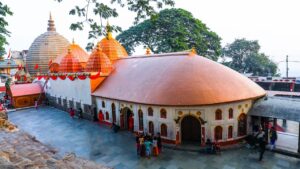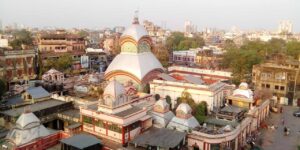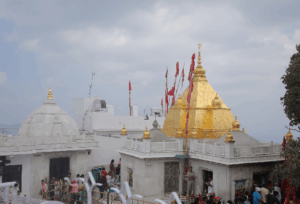Sri Vishalakshi Temple: Varanasi, Uttar Pradesh
The Sri Vishalakshi Temple, located in the spiritual city of Varanasi, Uttar Pradesh, is one of the most revered Shakti Peethas in India. Dedicated to Goddess Vishalakshi, a form of Goddess Parvati, this temple stands as a powerful symbol of divine feminine energy and maternal grace. The temple’s name, “Vishalakshi”, translates to “She who has wide eyes”, reflecting the goddess’s watchfulness and compassion toward her devotees.
Mythological Background
The origin of the temple is deeply rooted in the ancient tale of Goddess Sati. According to Hindu mythology, when Goddess Sati immolated herself due to her father Daksha’s insult to Lord Shiva, the grief-stricken Shiva carried her body across the universe. To restore cosmic balance, Lord Vishnu cut Sati’s body into 51 parts using his Sudarshan Chakra, which fell on different parts of the Indian subcontinent. Each site became a Shakti Peetha, and it is believed that Sati’s earring (kundal) fell at Varanasi, sanctifying the land where the Vishalakshi Temple now stands.
Spiritual Significance
The Sri Vishalakshi Temple is not only a significant Shakti Peetha but also a vital part of the Trisundari Peeths, alongside the Kamakshi Temple (Kanchipuram) and Meenakshi Temple (Madurai). These three temples are devoted to the goddess in her powerful forms and are revered together in tantric worship traditions.
In the spiritual fabric of Varanasi—a city known for liberation (moksha)—this temple stands out as a center of Shakti Sadhana, where devotees seek blessings for health, wisdom, marriage, and spiritual upliftment. It is especially popular among women, who pray for a happy married life and family prosperity.
Temple Architecture and Atmosphere
Tucked within the narrow lanes of Mir Ghat, the Vishalakshi Temple is modest in size but immensely powerful in spiritual aura. The idol of the goddess is beautifully adorned with flowers, sarees, jewelry, and a serene expression of compassion and strength. The temple premises are decorated with colorful paintings and carvings, and the constant sound of bells and chants adds to the divine atmosphere.
The temple’s proximity to the Kashi Vishwanath Temple and the Ganga River further amplifies its spiritual energy. Many devotees perform Ganga snan (ritual bath) before visiting the temple, making it part of a powerful pilgrimage circuit within Varanasi.
Festivals and Celebrations
Navratri is the most celebrated festival here, during which the temple is illuminated, and devotees flock in large numbers to offer prayers, participate in special pujas, and chant the goddess’s names. The temple also holds significance during Kajali Teej and other local festivals dedicated to the goddess.
On Shakti Peetha Mahotsav, special rituals are performed to honor the divine energy and recall the legend of Sati, reinforcing the temple’s historical and mythological importance.
Conclusion
The Sri Vishalakshi Temple is a timeless beacon of spiritual devotion, feminine power, and divine blessings. Nestled in the holy city of Varanasi, this Shakti Peetha not only connects devotees to the cosmic mother but also weaves them into the rich tapestry of India’s sacred geography. For anyone visiting Varanasi, seeking blessings from Mother Vishalakshi is both a sacred duty and a soul-soothing experience.


















